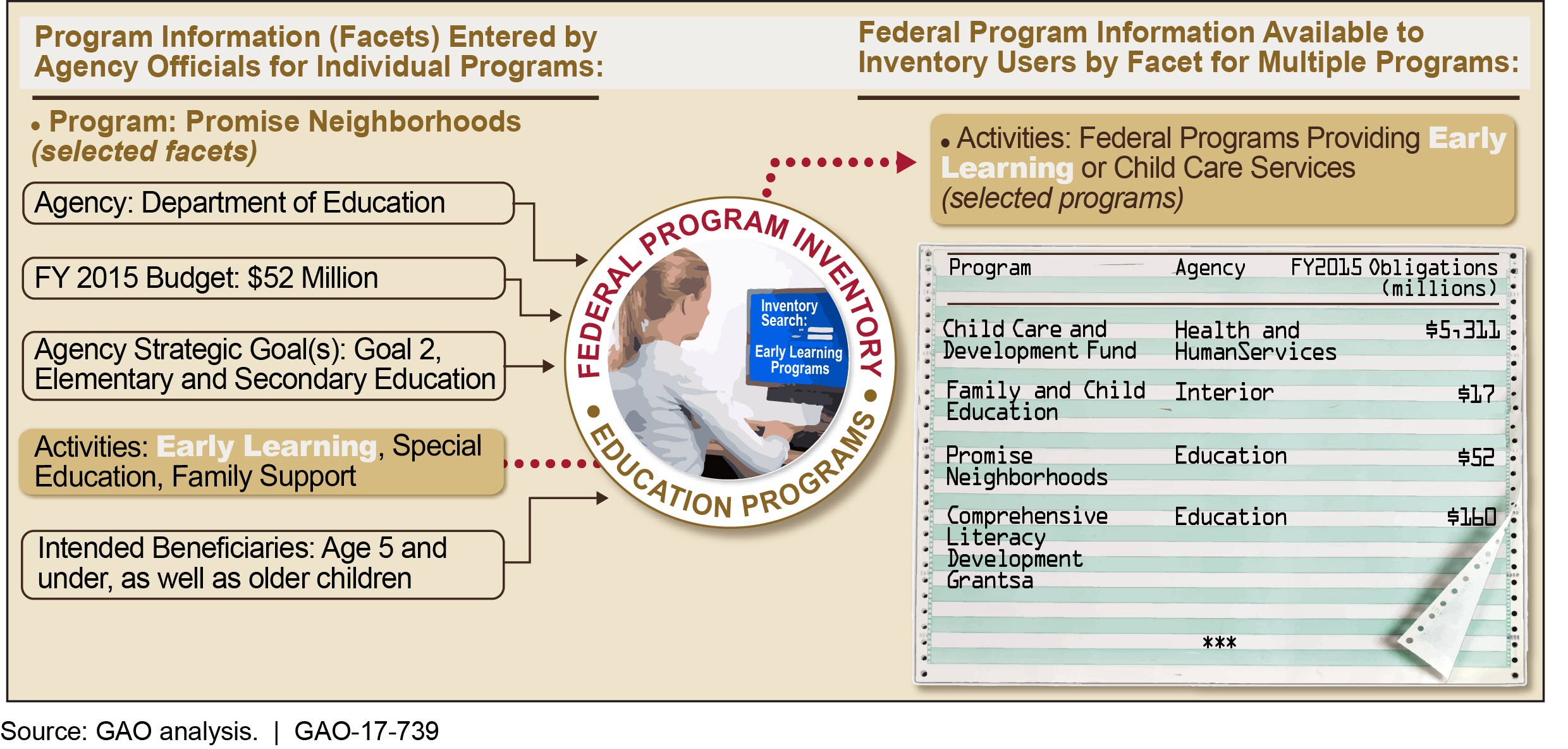Federal Programs: Information Architecture Offers a Potential Approach for Development of an Inventory
Fast Facts
We reported in 2015 that initial efforts to develop an inventory of federal programs—something that could make government more transparent and reveal areas of duplication and overlap—had fallen short due to inconsistent definitions and information across agencies.
In this report we examined how the principles and practices of information architecture—a discipline focused on how information is organized, structured, and presented—could help fix that.
We identified key steps drawn from information architecture for developing and maintaining such an inventory, enabling decision makers to more easily find and compare program information.
Hypothetical Example of Potential Benefits of a Federal Program Inventory

Illustration of a search for programs offering early learning or child care services in our hypothetical inventory
Highlights
What GAO Found
A useful federal program inventory would consist of all programs identified, information about each program, and the organizational structure of the programs and information about them. The principles and practices of information architecture—a discipline focused on organizing and structuring information—offer an approach for developing such an inventory to support a variety of uses, including increased transparency for federal programs. GAO identified a series of iterative steps that can be used to develop an inventory and potential benefits of following this approach. GAO also identified potential challenges agencies may face in developing a full program inventory.
Potential Process for Developing a Federal Program Inventory Based on Information Architecture

To identify potential benefits and challenges to applying these steps, GAO developed a hypothetical inventory, focusing on three case study agencies—the Departments of Education (Education) and Homeland Security and the U.S. Agency for International Development. Potential benefits of using such an approach to develop a federal program inventory include the following:
Stakeholders have the opportunity to provide input into decisions affecting the structure and content of the inventory. For example, congressional staff told GAO that an inventory with 5 years of budgetary trend data on programs would be more useful than 3 years of data.
A range of information through program facets is available for cross-program comparisons, such as budget, performance, beneficiaries, and activities.
An inventory creates the potential to aggregate, disaggregate, sort, and filter information across multiple program facets. For example, the figure below illustrates how program facets could be used to identify programs that provide similar services—in this case, early learning and child care services—and discover budget and other information for each of the programs identified.
An iterative approach to development and governance of the federal program inventory can result in improvements and expansions of the inventory over time.
Hypothetical Interface Illustrating Benefits of Searches in an Inventory Using Program Facets

GAO also identified potential challenges agencies may face when using this approach to develop an inventory, including the following:
Challenges in determining how agencies should identify and structure their programs in an inventory will need to be addressed, including how to treat spending categories not clearly linked to specific programs, such as administrative support. This may occur because agencies vary in their missions and organizational and budget structures and in how they organize their activities.
Challenges in collecting information for each program facet may occur for some agencies and programs. This may happen because a greater range of program information may be more readily available for some programs than others. GAO found that this was often dependent on the extent to which certain programs were included by name in budget documents, strategic plans, and agency websites.
Challenges related to determining what should be identified as a program and the structure and content of the inventory will need to be balanced with usefulness and costs. Agencies may need to weigh the costs that they might face in collecting and reporting program facet information as they establish priorities.
Why GAO Did This Study
Each year the federal government spends trillions of dollars through dozens of agencies and thousands of federal programs. Given its sheer size and scope, providing a clear and complete picture of what the federal government does and how much it costs has been a challenge in the absence of a comprehensive resource describing these programs. The GPRA Modernization Act of 2010 (GPRAMA) requires the Office of Management and Budget (OMB) to present a coherent picture of all federal programs by making information about each program available on a website to enhance the transparency of federal government programs.
Congress included a provision in GPRAMA for GAO to review the implementation of the act. GAO has chosen to conduct this study now because OMB has not yet developed an inventory that meets GPRAMA requirements. For this report, GAO addresses how one potential approach for organizing and structuring information—the principles and practices of information architecture—can be applied to develop a useful federal program inventory. To present illustrative examples of what programs and program information could be included in an inventory, GAO examined budget, performance, and other resources that could be used to develop an inventory. These examples were also used to illustrate the potential content and structure of an inventory and to identify any challenges.
GAO is not making recommendations in this report.
We provided a draft of this report for review and comment to the Director of the Office of Management and Budget (OMB), the Departments of Education and Homeland Security, the U.S. Agency for International Development (USAID), and the General Services Administration. USAID provided technical corrections, which GAO incorporated as appropriate. OMB agreed to consider this information architecture approach as it develops plans for the next iteration of the federal program inventory.
For more information, contact Elizabeth Curda at (202) 512-7215 or curdaE@gao.gov.
